What's New in 2025.1?
Seq 2025.1 is a huge leap forward, with full high availability (HA) and scale-out query execution, an updated query engine, new application features, and polished new front-end themes.
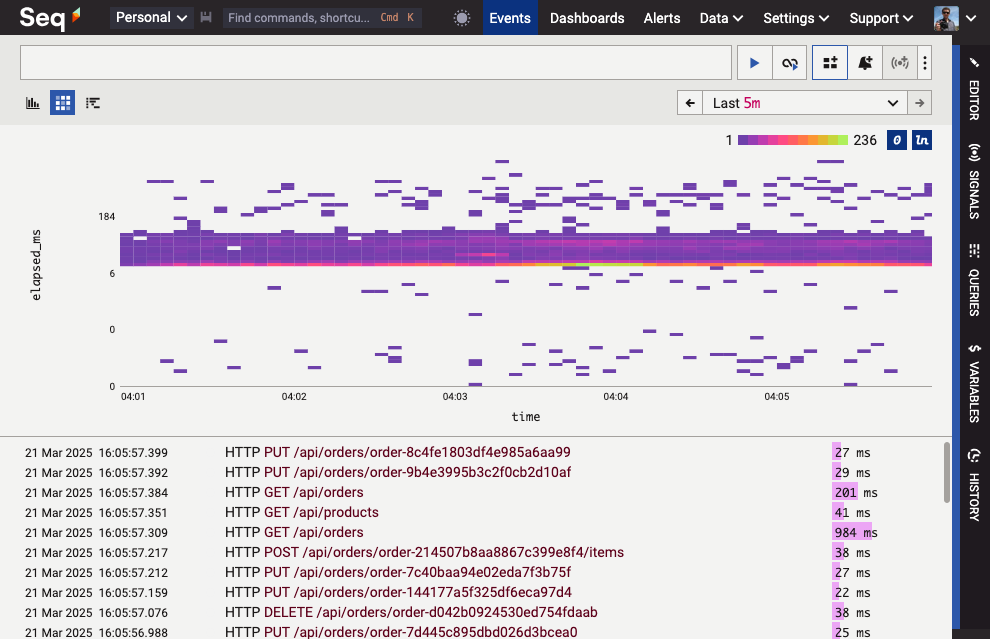
Highlights of 2025.1 include:
- Seq clusters now support nodes in a HA configuration with full unattended fail-over and scale-out query execution.
- Request latencies and similar datasets can be examined with the new heatmap visualization.
- Performance of
percentile()queries has been significantly improved. - Features and keyboard shortcuts are easier to find in the new
Ctrl-Kcommand palette . - Seq's internal system notifications such as disk space warnings can now be routed through an output app to reach email, chat, and other notification channels.
- More Seq queries now benefit from incremental result set memoization, accelerating repeat queries over slowly-changing data.
- The light theme has been completely redesigned to match the dark theme in comfort and style, and both themes have been significantly updated.
- Message template rendering now supports placeholders with dotted names, improving compatibility with OpenTelemetry and ECS naming schemes.
- The Seq query language now supports the
Replace(text, pattern, replacement)function for both substring and regular expression find-and-replace. - Improved navigation in the Data, Settings, and user preferences areas.
We've also paid special attention to tracking down and fixing as many borderline bugs, rough edges, and usability problems as possible. No software is perfect, but Seq 2025.1 is our closest attempt yet!
What's new in 2024.3?
User-defined, high-cardinality indexes make Seq 2024.3 the most efficient and responsive Seq yet. High-cardinality indexes target fields like request ids, client IP addresses, URIs, and email addresses, where the large number of possible values makes using signals — Seq's other index type — impractical.
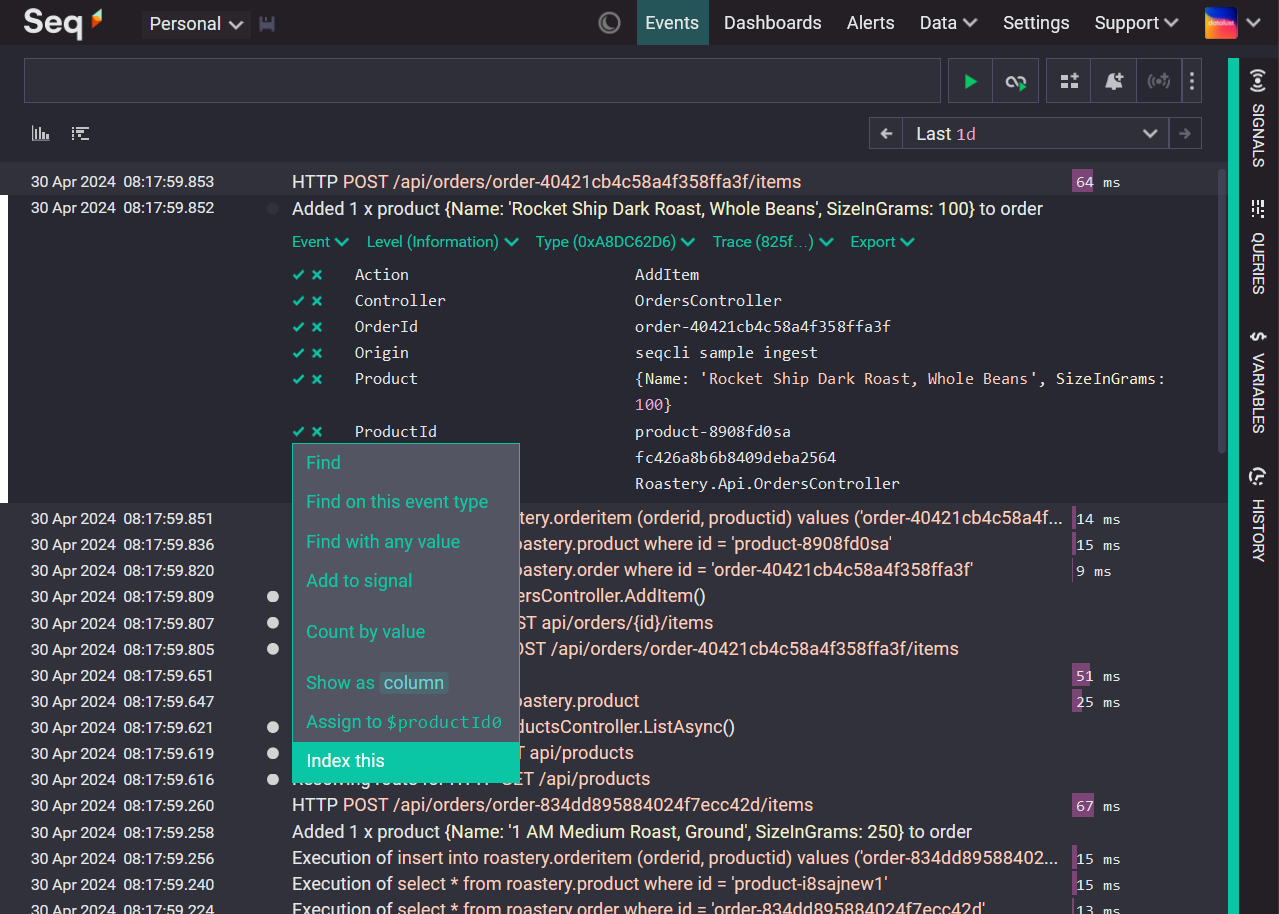
High-cardinality indexes can be defined from the new "Index this" menu item when interacting with properties on the events page.
Seq 2024.3 adds a new Indexes page under the Data menu. This page gives server administrators a complete view of all active indexes and a way to suppress or delete them.
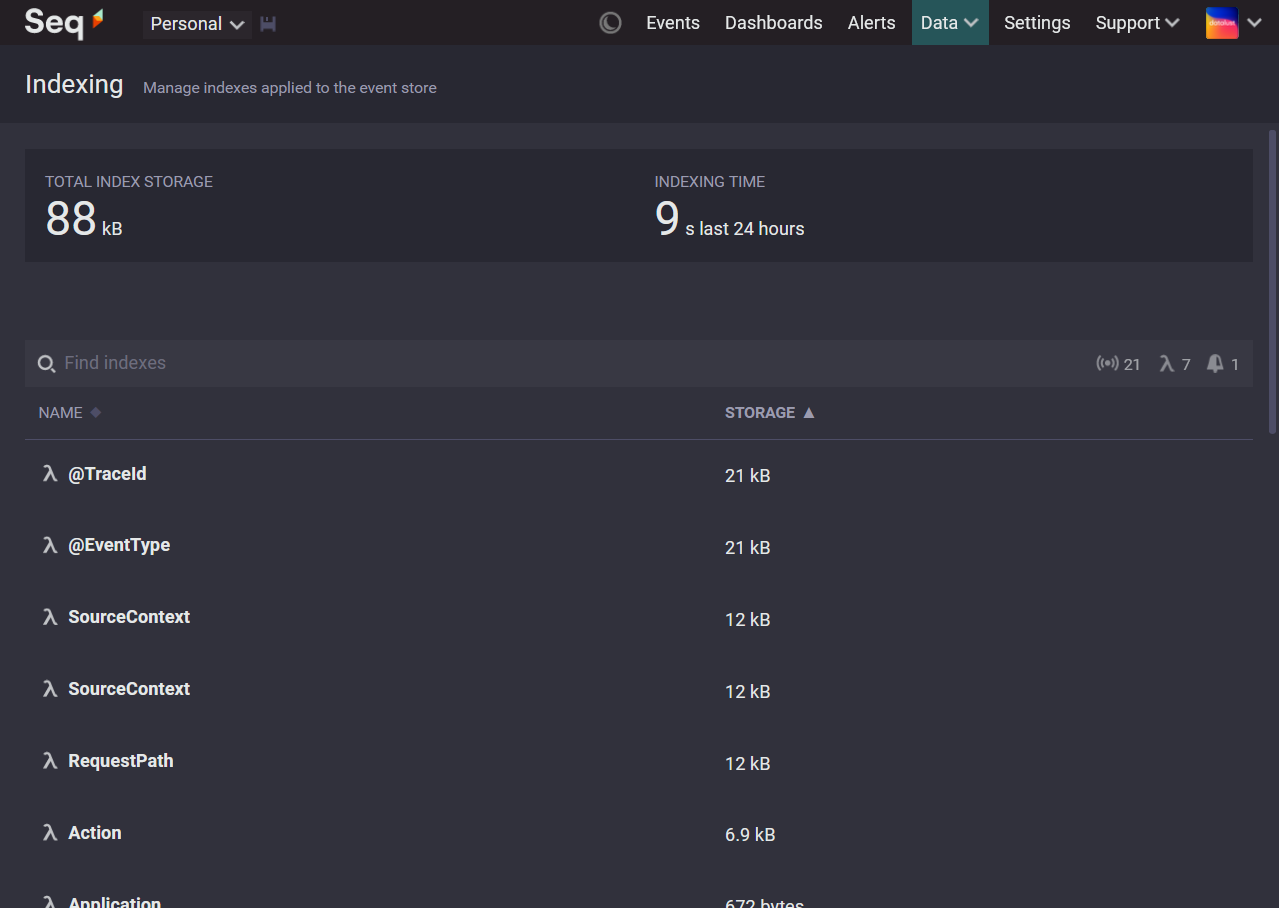
The new indexes page showing the total index storage size of 88kb and total indexing time in the last day as 9 seconds.
What's new in 2024.2?
Seq 2024.2 features a range of usability improvements in the events page.
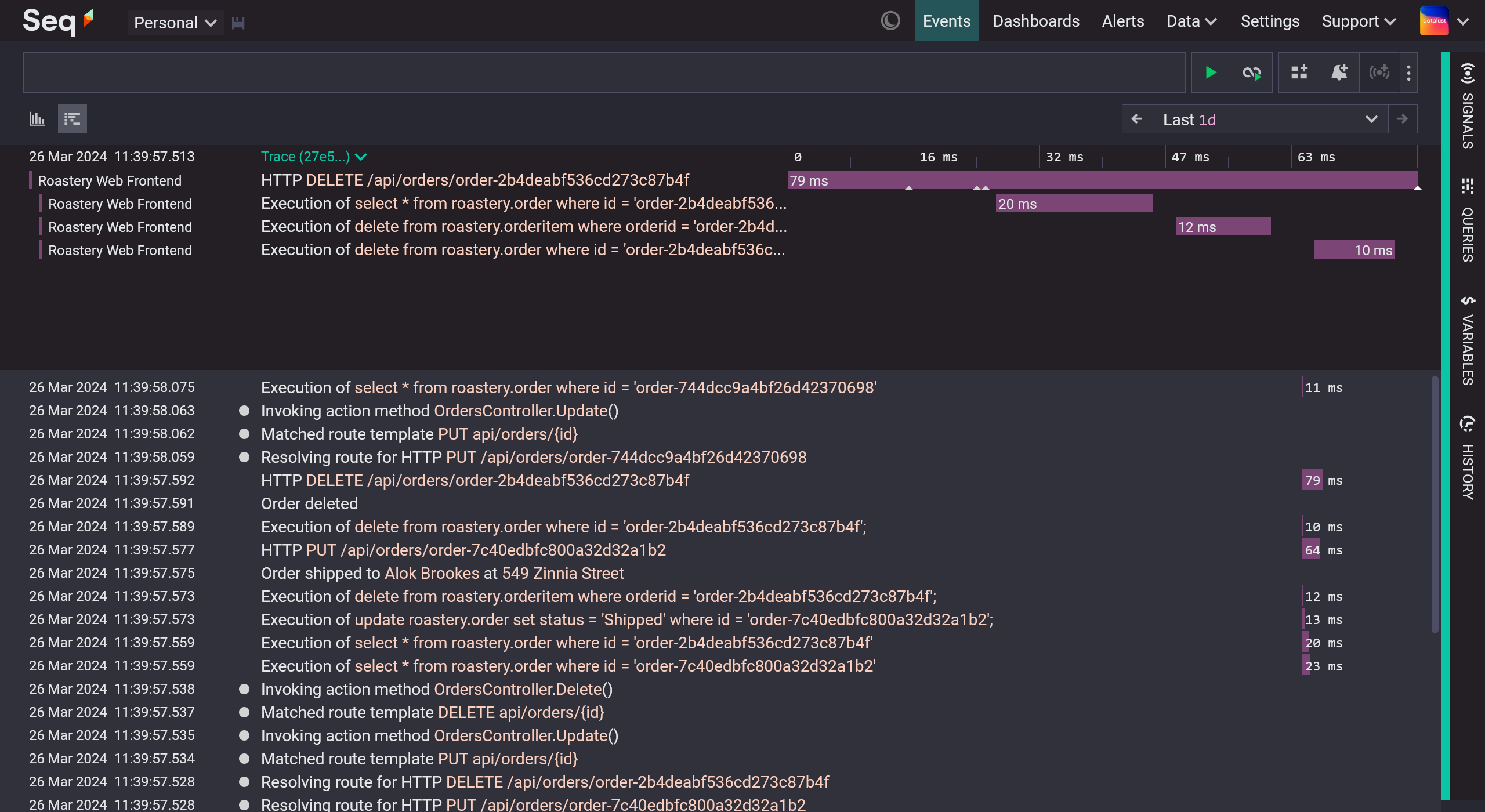
A distributed trace showing four spans, with four event markers in the root span.
Highlights include:
- Markers in the trace view for events that were logged within a span. Only events that are also visible in the event log below will be shown, better linking what you see in the log with what you see on the trace.
- Span names render as a message template instead of plain text, just like messages in the event log.
- Span kinds are recorded within traces, allowing the trace view to visually distinguish client-side spans from server-side ones.
- Service names gain a colored bar in the trace view so it's easier to see their relative depth in the trace.
- Range picker interactions are streamlined when working with custom time ranges. If you input a custom date range, subsequent interactions with the picker will open the calendar control instead of forcing you to select it from the dropdown, saving a click per interaction.
- Complex event properties can toggle between flattened or nested views inline. For "nesty" log models like OpenTelemetry, the new default of flattening event properties into a single level works well, but for other models it's less ideal. You can now flatten or unflatten nested properties directly in an event's property list.
- Queries that constrain
@EventTypenow use an index to achieve significantly faster responses.
See the full release milestone on GitHub .
What's new in 2024.1?
Seq 2024.1 is the first to include fully integrated support for tracing, including:
- Ingestion of traces using OpenTelemetry OTLP or as log events through the existing HTTP API.
- A brand new UI in the events page for viewing and interacting with traces.
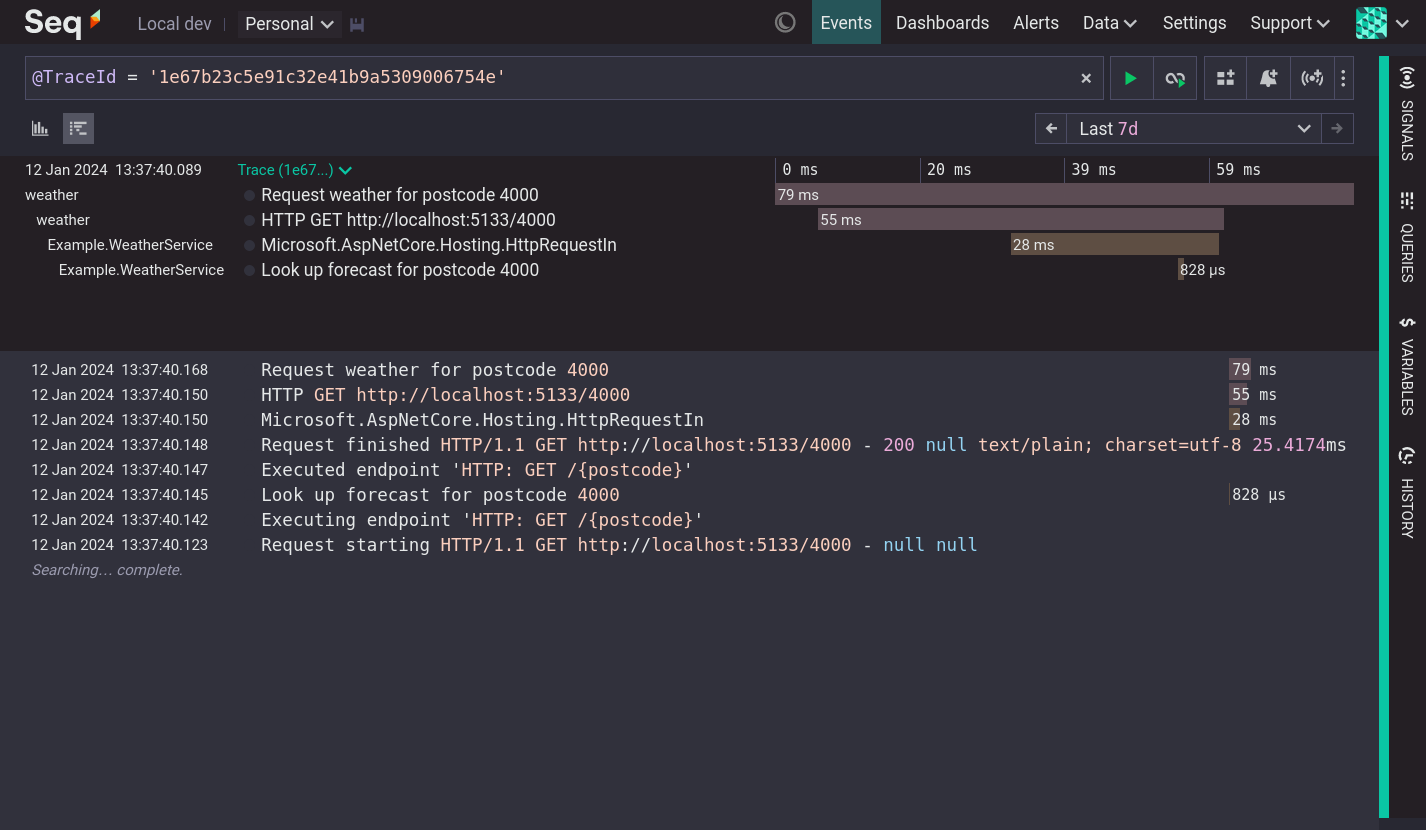
A distributed trace including spans and logs
This release also offers modest performance improvements across the board for running queries.
See the full release milestone on GitHub.
What's new in 2023.4?
Seq 2023.4 features an improved date range selector, with easy selection of recent ranges and the ability to page back and forward through time.
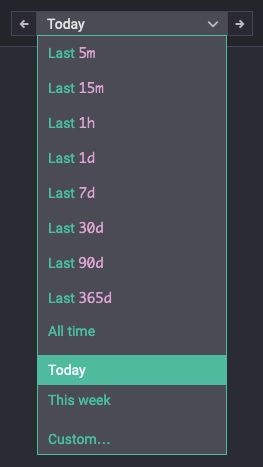
The same date range selector allows dashboards to display data for any historical period.
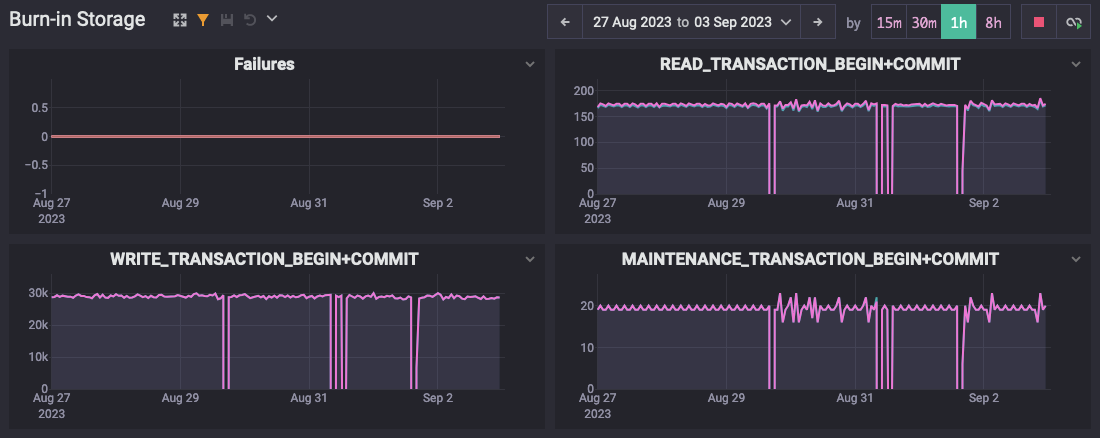
The search and query autocomplete has improved ergonomics and capability, helping to complete property names, Seq keywords and variables.

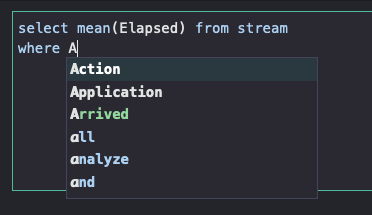
This release includes a number of performance enhancements, especially for large servers that are ingesting a high volume of events.
See the GitHub release milestonefor a complete list of included changes.
What's new in 2023.3?
Seq 2023.3 introduces the fantastic lateral unnest(arr) query language feature and adds secure built-in auditing to Seq Datacenter.
See the full release milestone on GitHub.
What's new in 2023.2?
Seq 2023.2 adds a native ingestion endpoint for the OpenTelemetry logs protocol (OTLP).
The release milestone on GitHub lists more improvements and bug fixes included in 2023.2.
What's new in 2023.1?
Seq 2023.1 introduces a brand new query engine, built in Rust, that parallelizes work efficiently across large numbers of cores, makes better use of signal indexes to accelerate queries, and works in harmony with the host operating system to manage memory safely in containerized environments.

100 GB stream, AWS Graviton im4gn.4xlarge instance, 2 minutes 20 seconds vs 0.8 seconds.
🔥 Extreme sparse index performance — a new, unified storage architecture makes better use of indexes when querying recent events, yielding order-of-magnitude execution time improvements on many searches.
🤹♀️ Smooth multicore scaling — the new query engine utilizes as many cores as the host can provide, leading to better overall utilization and faster query response times.
⚓ Easier management in Docker and Kubernetes — a range of updates make Seq work in harmony with container hosts, in a wider range of environments.
For a complete list of bug fixes and improvements shipping with Seq 2023.1, please see the release milestone on GitHub.
What's new in 2022.1?
Seq 2022.1 completely reshapes the signal bar. Large signal lists are easier to work with, search history is now searchable, there's a better signal editor, and a new variables window that supports a unique and powerful diagnostic experience.
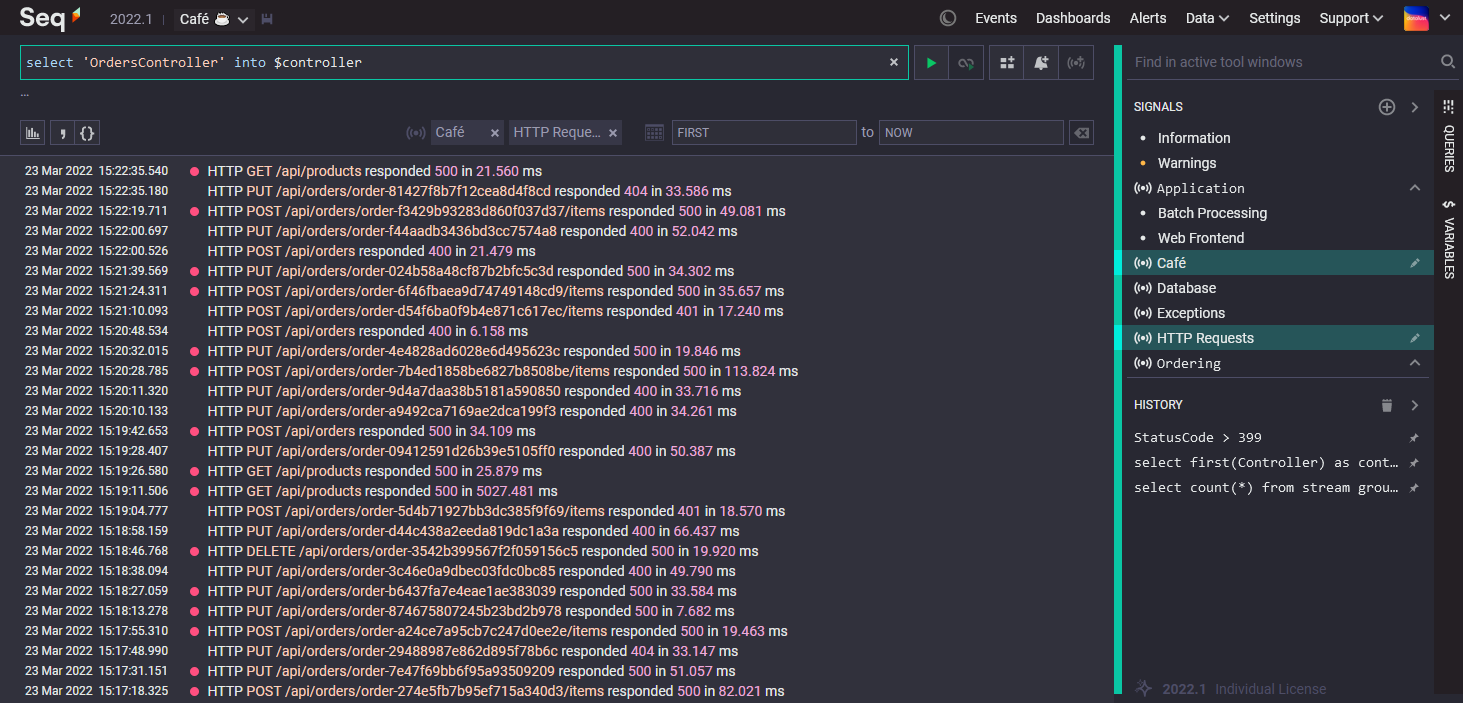
Seq 2022.1, showing the new signal bar organization, and query syntax for assigning a variable.
Active signals are now displayed as tags above the result list, so that the scope of the current result set is clear even when the signal list is off-screen.
Variables allow property values and other useful information to be given names and then used within queries and searches. By assigning a large or complex object to a named variable such as $request, it's possible to inspect and evaluate expressions against its subproperties with queries like select $response.Orders[1].ShippedAt.
The coalsece() and concat() query functions now support variable-length argument lists, and substring()'s third length argument is now optional. The query language function and operator documentation also received a major overhaul, and should be more accurate, detailed, and consistent than the earlier version.
New Project Owner and Organization Administrator roles provide the option to grant more capabilities to users while limiting access to critical system-level administration features.
For a complete list of 2021.1's improvements and bug fixes, see the release milestone on GitHub.
What's new in 2021.4?
Seq 2021.4 adds 64-bit ARM platform support to the datalust/seq Docker image. The image is tested on Apple Silicon (M1 and later Macs), AWS Graviton, and Raspberry Pi 4.
Machines running the preview ARM support included in some Seq 2021.3 builds must be upgraded directly to Seq 2021.4 to ensure compatibility with future Seq releases.
Also in 2021.4:
- Application URLs are preserved when redirecting through the Seq login page
- Seq App settings can specify
Syntaxto direct the UI to render them in a fixed-width font - Signal bar highlighting is turned off on mobile devices; this improves user experience significantly on iPad and similar form factors
- The bundled
seqclihas received a number of fixes and improvements
The release milestone on GitHub lists some additional small bug fixes that made it into the 2021.4 release.
What's new in 2021.3?
In Seq 2021.3, Alerts get their own top-level status-oriented dashboard, a much better editing experience, and rich, multi-channel notifications.

Seq 2021.3 Alerts dashboard, showing notification history and current trigger status of several alerts.
Integrated disaster recovery (DR) and support for zero-downtime upgrades make managing Seq easier in enterprise and datacenter environments.
Hosting Seq in Docker gets a major upgrade, with a new secret store, init script support, support for serving HTTPS without a reverse proxy, better Linux virtual memory manager integration, and a new shell entrypoint for performing maintenance.
Seq 2021.3 includes improvements across the entire product:
- The search bar button layout and icons have been redesigned, providing quick access to JSON and CSV export
- The Events screen date range picker gains support for millisecond precision
- PostgreSQL is added alongside SQL Server/Azure SQL Database for robust external metadata storage
- The Seq query language gains
letbindings and lambda syntax for collection search operations - A dedicated
/healthendpoint, and a range of newseqclicommands make deploying and operating Seq 2021.3 a breeze - Seq can now be installed and run under a Group Managed Service Account (gMSA) on Windows Server
- Signals, dashboards, queries, retention policies, and workspaces can now be exported, imported, and synchronized between servers with
seqcli template exportandseqcli template import - Secret key providers enable storing the primary Seq encryption key in an external key management service
Check out the release milestone on GitHub for a full list of included features and bug fixes, and the upgrade guide if you have an existing Seq instance to update.
What's new in 2021.2?
Seq 2021.2 extends Seq's built-in query language with the new DatePart() and OffsetIn() functions.
Seq 2021.2 uses .NET 5.0.4, which addresses a remote-code-execution vulnerability in .NET 5.
For detailed release contents, see the GitHub milestone. Seq 2021.2 also rolls up the final Seq 2021.1 patch release; see also the 2021.1.5424 milestone.
What's new in 2021.1?
Seq 2021.1 includes:
- Collapse all is now an option on nested objects in event properties
- OpenID Connect and Azure Active Directory authentication now work properly under Kubernetes ingress paths
- The dashboard Save button now enables immediately when typing in the query editor
- Seq 2021.1 uses .NET 5.0.2, which addresses a denial-of-service vulnerability in .NET 5
- Various query parsing and translation bugs have been fixed
seqcli user createnow applies user roles correctly from the command-line
For detailed release contents, see the GitHub milestone.
What's new in 2020.5?
Seq 2020.5 is the first Seq version to run under .NET 5, bringing further improvements in execution time for some fundamental queries:
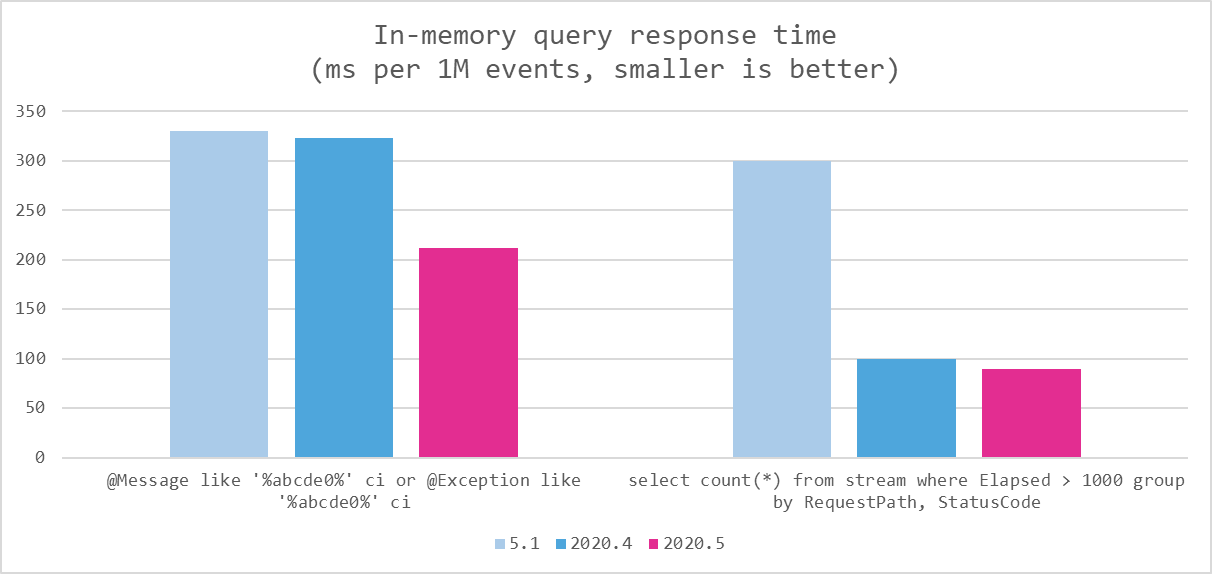
Seq 2020.5 query performance against 2020.4 and 5.1, with data served from memory and from/to dates specified.
In 2020.5, Seq plug-in apps and inputs run under the open-source seqcli app host, making development easier and cross-platform deployment more reliable.
We've also managed to save some bytes to shrink the Windows installer (34%) and Docker image (16%, compressed).
Oh, and workspaces have been redesigned: you can now associate default signals with a workspace, and they'll be activated when you switch between workspaces 😎.
For detailed release contents, see the GitHub milestone.
For additional upgrade instructions, see the Upgrading guide.
What's new in 2020.4?
Seq 2020.4 is all about the Storage screen — see exactly where disk space is going, and how effective retention policies are at freeing up resources.
You can find it under Data > Storage.
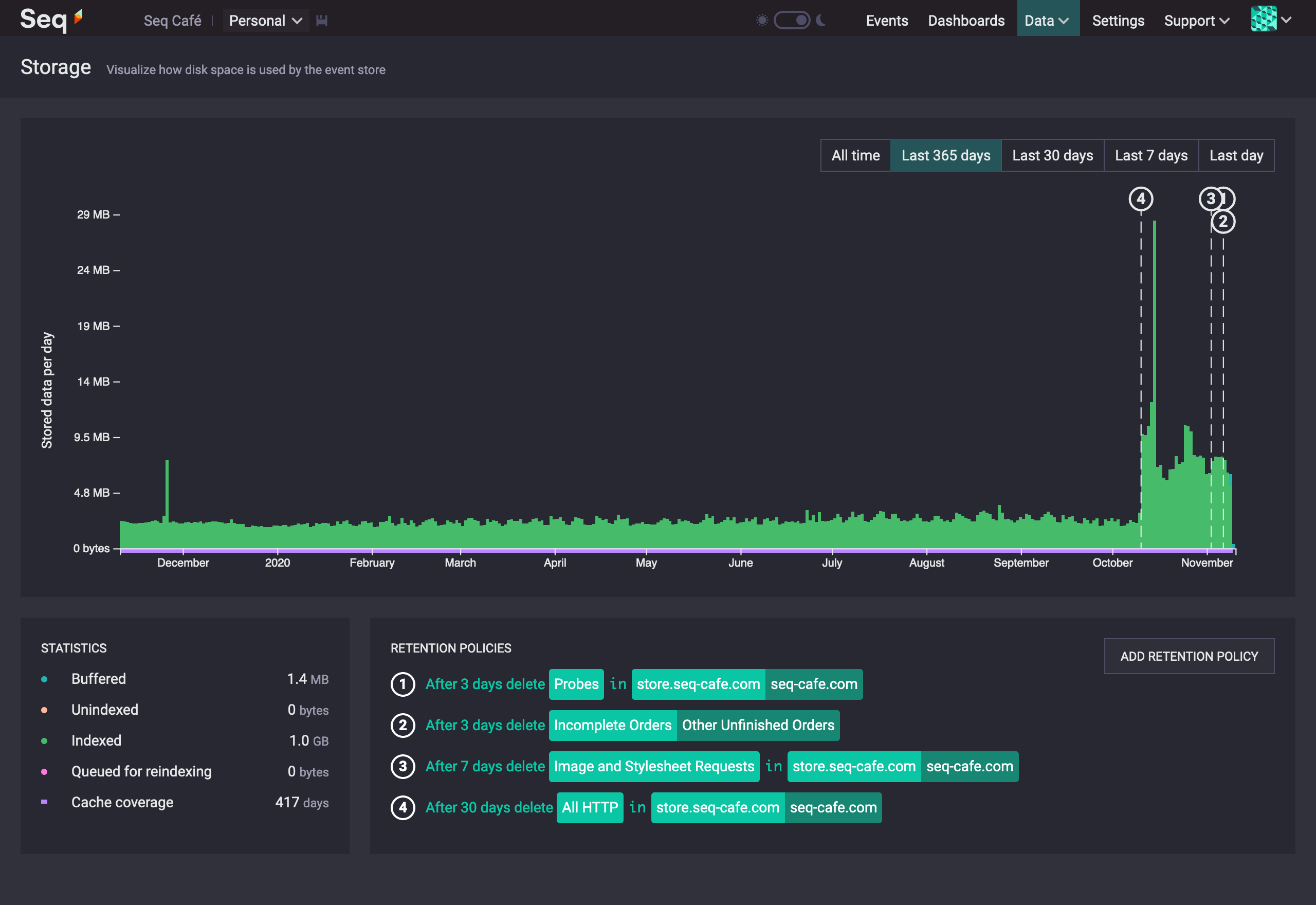
Seq 2020.4 storage view, showing retention policy markers.
The Settings > Users list is also now fully searchable (a relief for customers with hundreds of active users!); dark and light modes can be set to follow your operating system's dark/light setting; all queries are now fully cancellable; entire events can be easily copied as JSON; and, as always, there's a host of other small fixes and improvements.
For detailed release contents, see the GitHub milestone.
What's new in 2020.3?
Seq 2020.3 fixes a number of issues, and improves stability for customers using Azure Active Directory (AAD) authentication. We've also made some much-anticipated changes to live tailing to make live log streams more responsive and easier to follow.
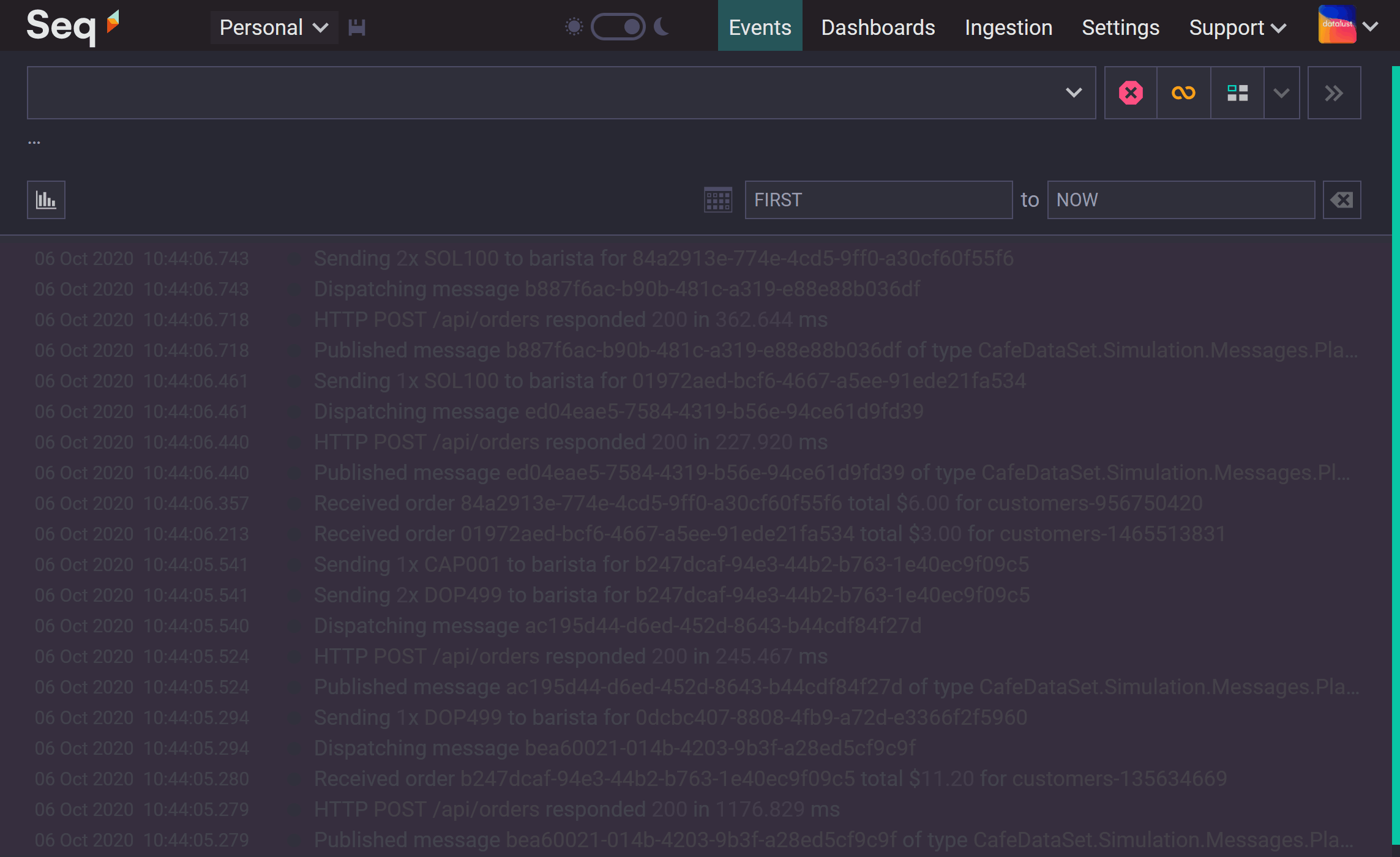
Improved live tailing in Seq 2020.3.
For detailed release contents, see the GitHub milestone.
What's new in 2020.2?
Seq 2020.2 adds an improved structured data viewer that simplifies working with nested objects, and support for SQL-style -- comments in queries and search expressions.
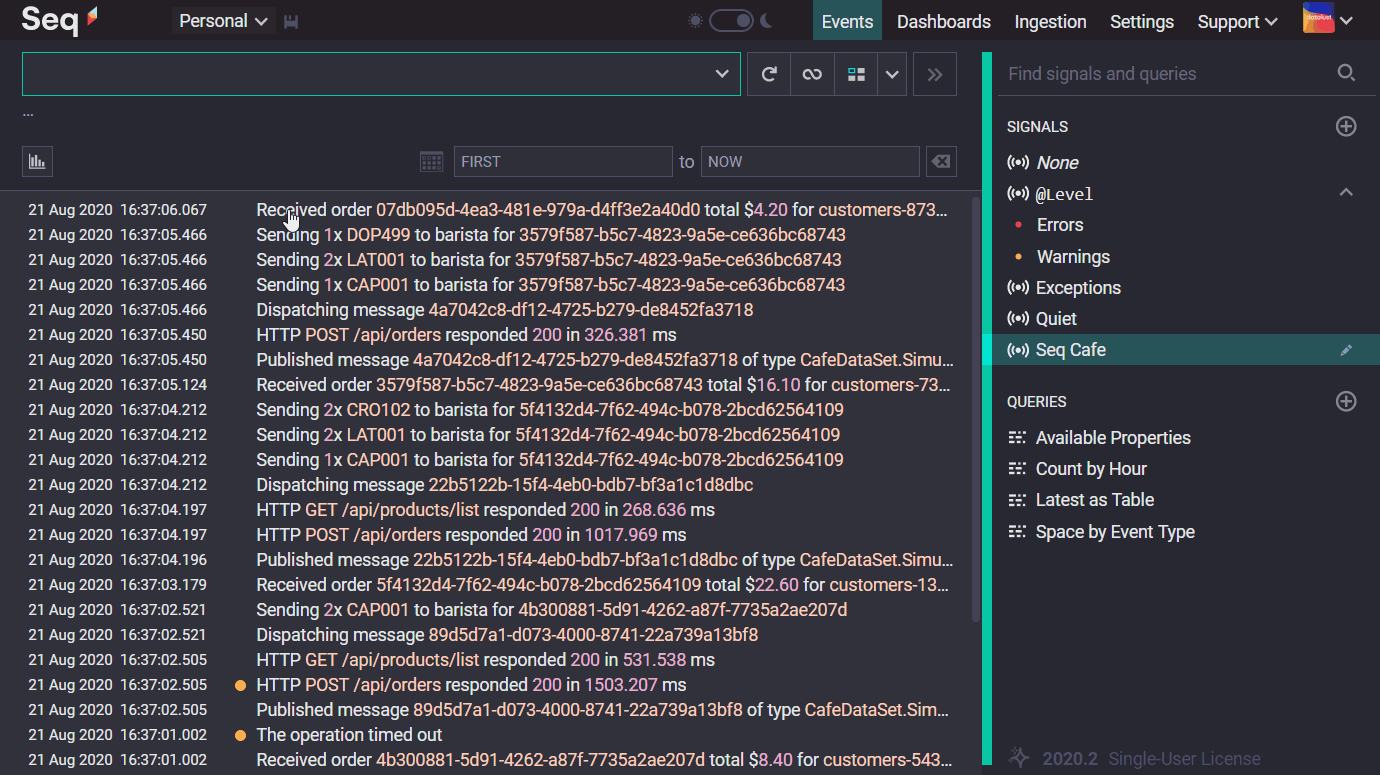
The Seq 2020.2 structured data viewer in action, searching for a value in an array of nested objects.
You'll also find a range of small enhancements and bug fixes.
For detailed release contents, see the GitHub milestone.
What's new in 2020.1?
Seq 2020.1 is packed with improvements over Seq 5.1. Managing log ingestion is the key to controlling costs and optimizing search performance. Seq 2020.1's Ingestion screen makes this much, much easier, by providing a detailed breakdown of log traffic from the ingestion API and custom inputs.
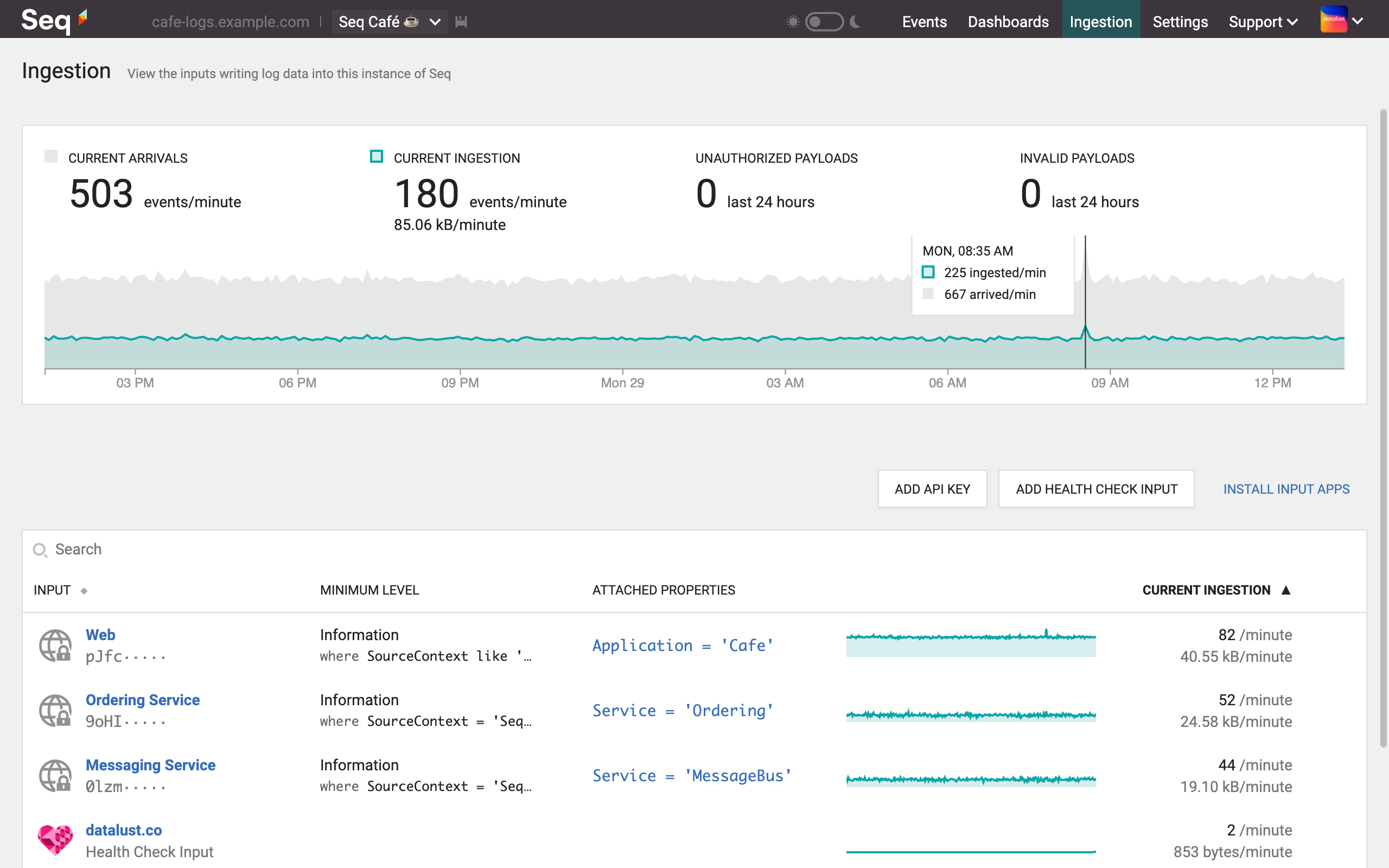
The Seq 2020.1 Ingestion screen.
Learn more about managing ingestion.
Other highlights include:
- OpenID Connect authentication — Seq can now use OpenID Connect to authenticate users. Learn more about configuring OpenID Connect authentication.
- Full-featured custom inputs — Custom inputs including GELF, Syslog, RabbitMQ, Health Check, and others, now get all the filtering, enrichment, and monitoring features of Seq's built-in HTTP ingestion pipeline! For an example of a very useful custom input, check out the documentation for Health Checks.
- Query language improvements — 2020.1 continues to improve upon Seq’s query language, making it easier to express a variety of queries. Additions include the universal case-insensitive (
ci) modifier, supporting case-insensitivegroup by, property access, comparisons, and more. - Native, parallel query execution — The underlying query engine in Seq 2020.1 includes a new native implementation in Rust that squeezes more performance from the same hardware.
- Theme switcher — 🌞 in the morning, 🌚 in the evening? The quick theme switcher in the 2020.1 navbar makes dark or light mode a single click away.
- Revised keyboard navigation — The tab order and focus styles have been improved throughout, making it easier and faster to move between elements in the Seq UI without reaching for a mouse.
You can find detailed release notes in our 2020.1 issue tracker milestone.
Updated 3 months ago
